Any injury, compression, or irritation in the sciatic nerve or lower vertebrae causes sciatica pain. Sciatica is also caused by overusing the injured muscles of the leg. The pain is characterized by a sharp, burning, or throbbing sensation that radiates down your leg.
The longest and largest nerve in your body with its roots starting in your lower back and running down through your buttocks, thighs, and along the side of each leg, is called sciatic nerve. The thickness of the sciatic nerve is about 2 centimeters and it is not a single nerve. It is a bundle of nerves originating from five nerve roots in your spinal cord. Each side of your body has one sciatic nerve, that means one bundle. Each sciatic nerve runs down to the leg of its side through your hip and buttock of that side. Near the knee, this sciatic nerve splits into other nerves that approach the farther parts including your shin, foot, and toes.
Overview of Sciatica Pain
It is a nerve pain caused by an injury or irritation to your sciatic nerve. Tingling and numbness in your back and butt are signs of sciatica pain. Experiencing sciatica pain means you have mild to severe pain in your lower back, hips, buttocks, or legs. Sometimes the pain extends to as far down as your feet and toes. Usually, sciatica pain affects only one side of your body.
Sciatica pain generally is not more than a minor nuisance causing mild discomfort, but sometimes it causes severe pain. People usually don’t take it as a dangerous or serious condition and get better on their own with self-care treatments at home. In severe pain, doctors may suggest surgery to treat sciatica pain.
Types of Sciatica Pain
There are two types of sciatica pain but the effects of both types are similar. The types are:
- Sciatica Like Conditions.
- True Sciatica Pain.
Sciatica-Like Conditions: These pains are caused by the discomfort in the nerves related to the sciatic nerve or the nerves that bundle together to the sciatic nerve but feel like sciatica pain.
True Sciatica Pain: When any injury or condition directly affects your sciatic nerve and you feel pain, burning, or numbness, this is true sciatica.
How to Manage Sciatica Pain?
This nerve pain has a painful history because, since the 5th century, doctors have been trying to find out effective remedies. In ancient times they used hot coals and leeches to manage the pain and in the 20th century, you are familiar with creams and lotions that can relieve sciatica pain. In 2007, a study revealed that 10 percent of the adult population in the country is suffering from sciatica pain. Normally a person has 50 percent probability to experience sciatica pain in life span. But the good news is that the struggles of healthcare providers have brought a revolutionary twist in the medical history of sciatica pain treatment by introducing mindful and targeted yoga practices that can help you overcome the pain.
How can Yoga Relieve Sciatica Pain?
Usually, the treatment method or yoga poses to treat sciatica pain depends on the type of sciatic nerve that was damaged or injured. For example, if you are experiencing sciatica pain due to a herniated or bulging disc, yoga practice progresses from gentle practices to basic asanas like downward-facing or standing poses will strengthen your back and relieve pain. It means you don’t need surgery to treat a herniated disk. Yoga can help you reduce the intensity of pain. However, talk to your doctor about the severity of herniation because a healthcare provider will examine carefully whether surgery is required or not.
If you have sciatica pain due to pressure on your sciatic nerve, stretching the muscles will give you relief. Make your lifestyle gentle because overworking or excessive hard work may lead to deep buttock pain and spasms that may or may not be accompanied by sciatica pain.
In 2013, researchers revealed that yoga poses such as child’s pose, cobra pose, or half moon pose are proved useful in managing sciatica pain. Because yoga poses can:
- Improve limitations in activity.
- Reduce the use of pain-relieving medicines.
- Reduce chronic back pain.
- Improve mobility.
Let’s have a deeper look to learn how you can practice therapeutic poses of yoga to prevent and soothe sciatica.
Cobra Pose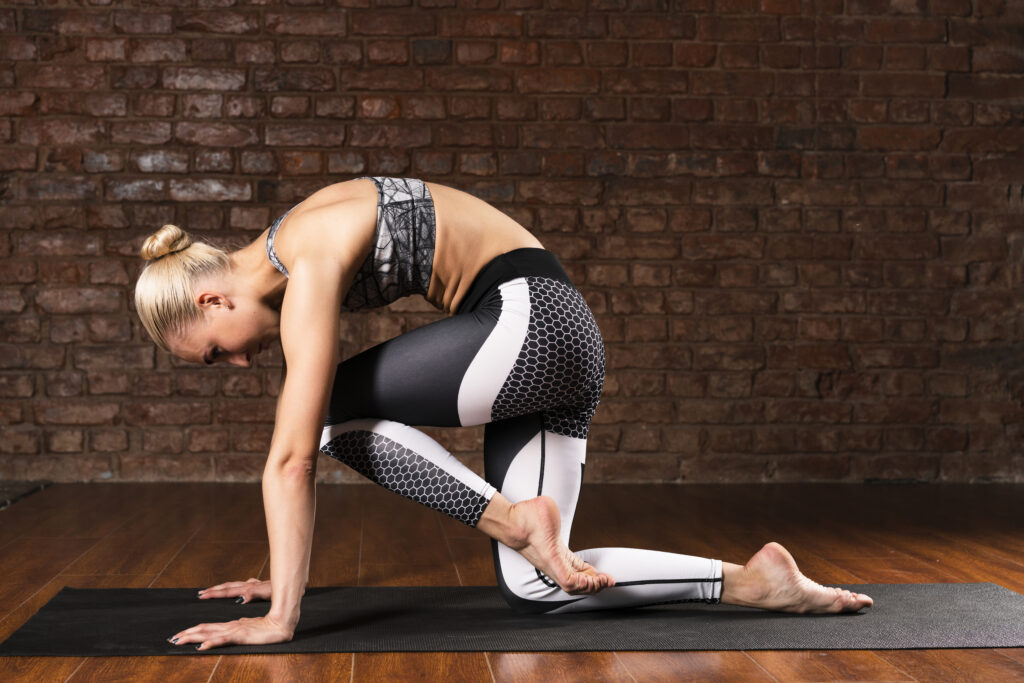 This is a very effective pose to soothe sciatica pain. Cobra pose stretches and strengthens your spine, promotes flexibility in vertebrae, and improves circulation.
This is a very effective pose to soothe sciatica pain. Cobra pose stretches and strengthens your spine, promotes flexibility in vertebrae, and improves circulation.
How to Practice Cobra Pose?
- Put your hands under your shoulders by lying on your stomach.
- Squeeze your elbows into your body’s sides.
- Lift your shoulders, chest, and head by inhaling.
- Keep your chest open and maintain a bend in your elbows.
- Put pressure on your abdominals, lower back, and thighs.
- Hold up for 20 seconds.
- Take rest for a few seconds after releasing the pose and repeat it at least three times.
Half-Moon Pose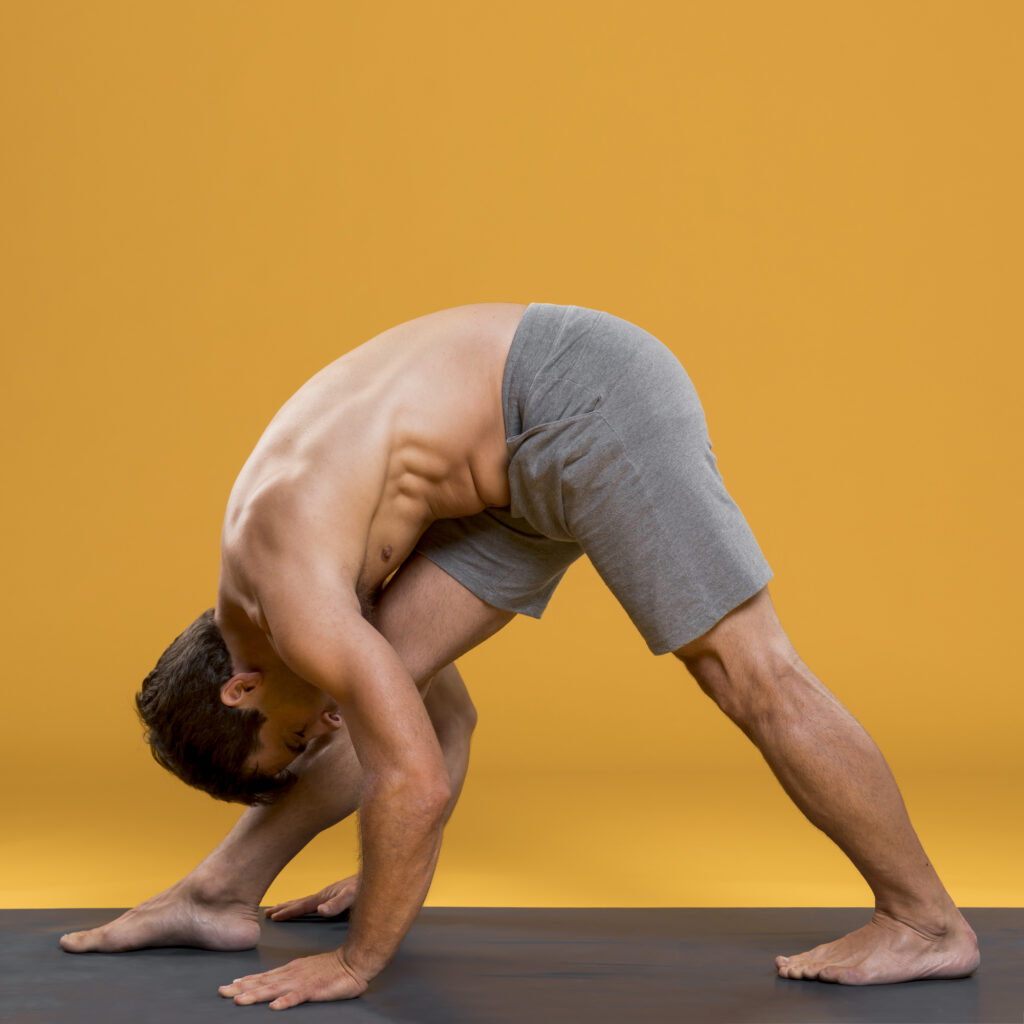 This yoga pose soothes your sciatica pain in no time. Half Moon Pose stabilizes your body and maintains the balance of your body. It improves mobility and flexibility, strengthening your thighs, glutes, and spine by relieving tension.
This yoga pose soothes your sciatica pain in no time. Half Moon Pose stabilizes your body and maintains the balance of your body. It improves mobility and flexibility, strengthening your thighs, glutes, and spine by relieving tension.
How to Practice Half Moon Pose?
- Take support by doing this pose against a wall and also place a wooden block under your hands.
- Stand in a triangle pose with your right foot in front.
- Yield your whole weight into your right foot by bending your right knee deeper.
- Put your left hand on your hip.
- As you reach your right hand, slide your left foot forward in front of you and put your right hand to the right of your right foot.
- Keep your left leg parallel to the floor and press it out with your left heel.
- Rotate and open your hip and torso.
- Lift your left hand towards the ceiling to go deeper and turn your gaze upward.
- Stay calm for up to 60 seconds.
- Slowly bend your right leg and lower your left leg to the floor to release the pose.
- Return to the initial standing pose.
- Repeat it on the opposite side.
Child’s Pose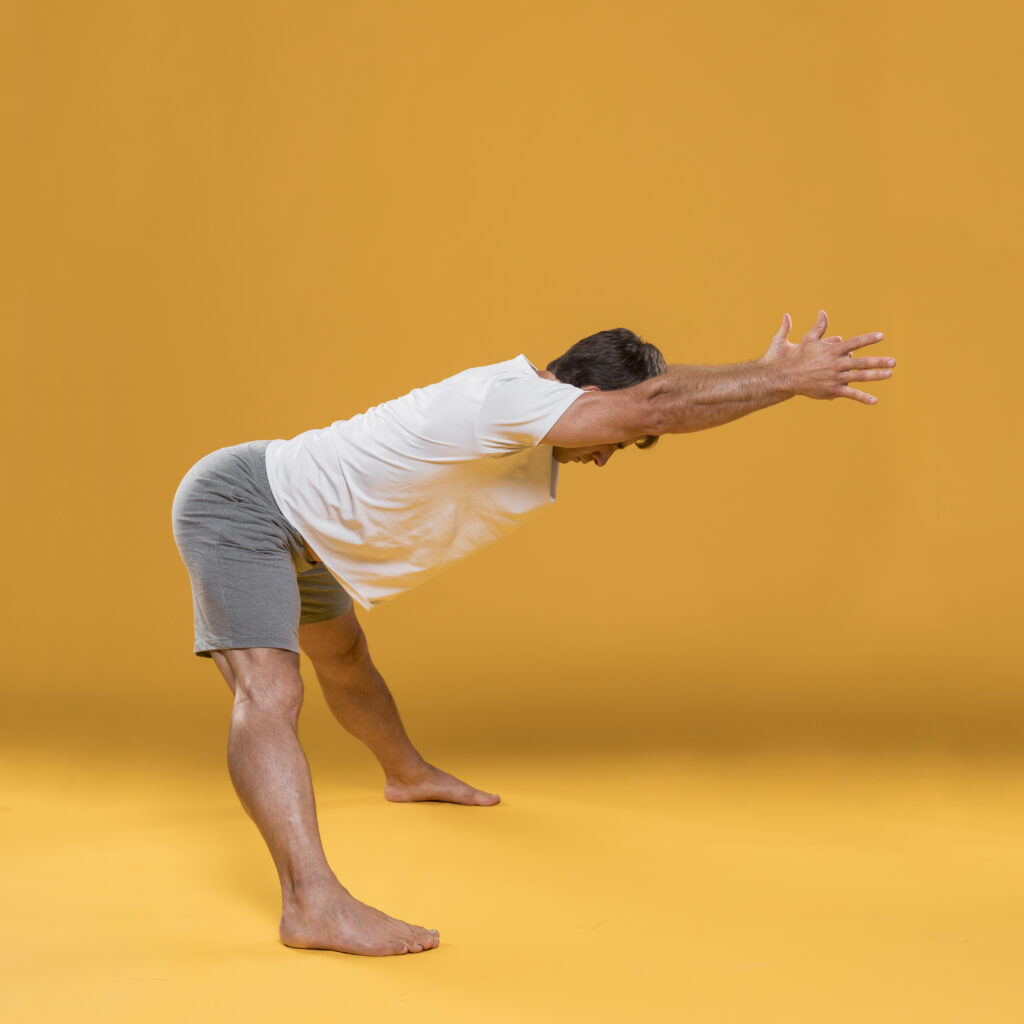 It is the most wonderful pose to relax your body. It not only stretches and lengthens your spine but also promotes openness and flexibility in your hips.
It is the most wonderful pose to relax your body. It not only stretches and lengthens your spine but also promotes openness and flexibility in your hips.
How to Practice Child’s Pose?
- Before starting, place a soft cushion under your forehead, chest, and thigh. This precaution will give you support.
- Now bring your knees closer and move your hips back onto your heels.
- Allow your arms to rest alongside your body by extending the arms in front of you.
- Fall heavy into your thighs while allowing your torso to relax completely.
- Relax your areas of tightness or sensation by breathing deeply.
- Keep your body in balance for up to 3 to 4 minutes.
Downward-Facing Dog Pose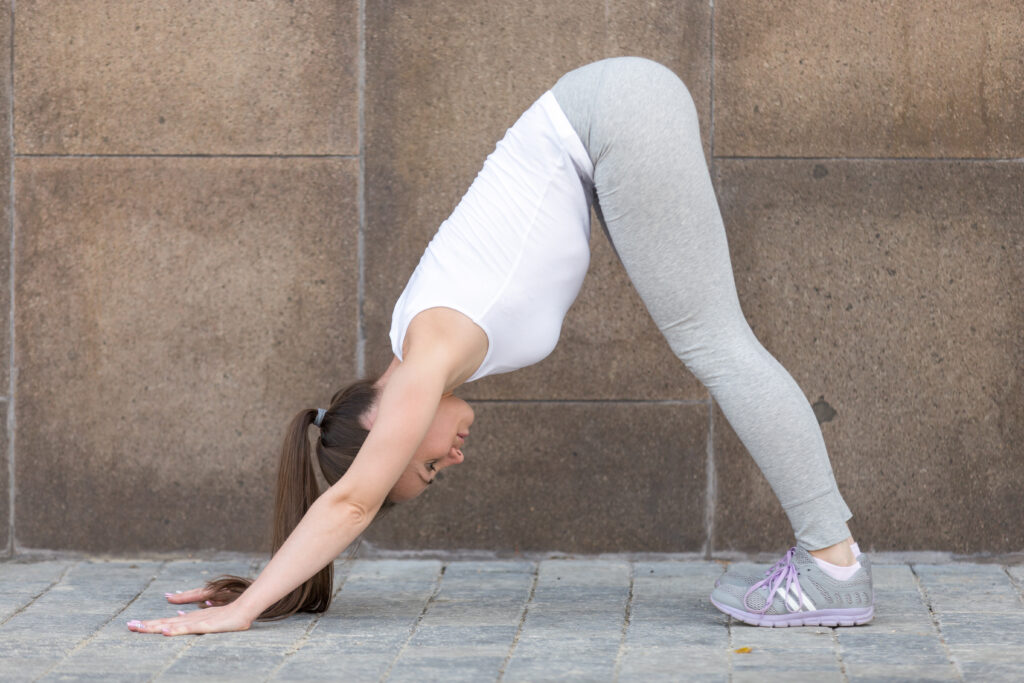 This pose supports your body alignment and relieves sciatica pain. This forward bending pose removes tightness from your muscles. Downward-facing dog yoga pose works best to improve your body balance and promote strength.
This pose supports your body alignment and relieves sciatica pain. This forward bending pose removes tightness from your muscles. Downward-facing dog yoga pose works best to improve your body balance and promote strength.
How to Practice Downward-Facing Dog Pose?
- Start with your knees and hands.
- Lift your hips towards the ceiling by pressing into your hands.
- Drop your head downward by keeping your chin in the direction of your chest.
- Bring your ears in line with your upper arms.
- Tilt your pelvis slightly forward by bending your knees.
- Move your body in various directions but in an appropriate way.
- Hold this pose for 30 to 40 seconds.
Knees-to-Chest Pose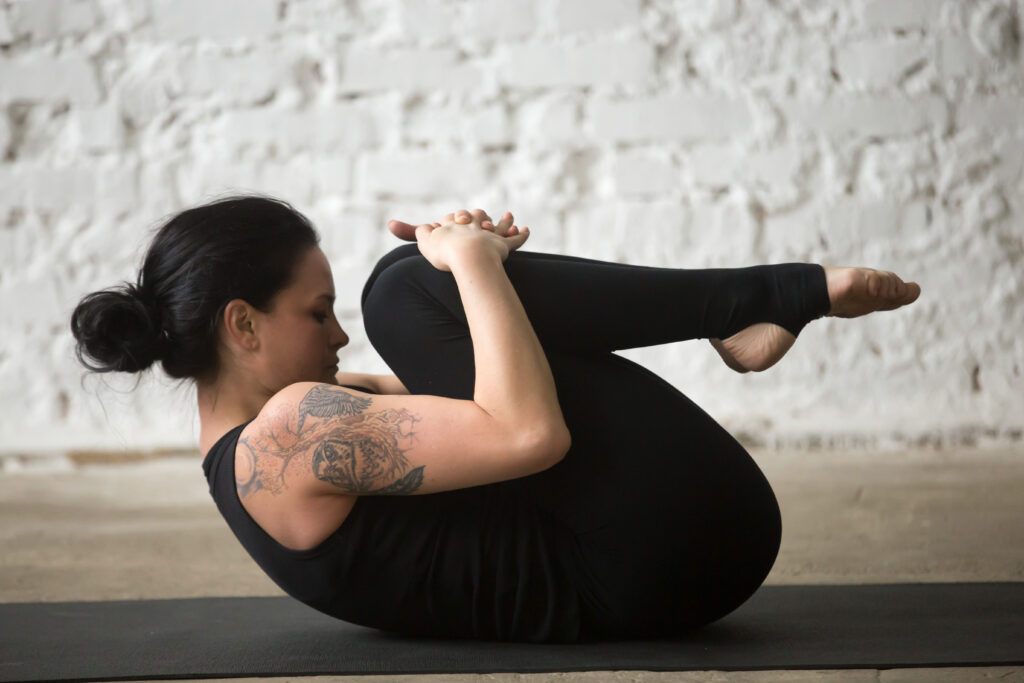 This pose helps to stretch an important pear-shaped muscle located in your buttock. Knees-to-Chest Pose is the best pose to strengthen the muscles in your piriformis and lower back.
This pose helps to stretch an important pear-shaped muscle located in your buttock. Knees-to-Chest Pose is the best pose to strengthen the muscles in your piriformis and lower back.
How to Practice Knees-to-Chest Pose?
- Initially, you will lie on your back and keep your legs straight.
- Keep the knees bent straight enough that your knees can touch the ground from the backside.
- Start inhaling.
- Now slowly bend your knees and bring your thighs close to your chest while exhaling.
- Keep your back flat against the ground while hugging your arms around your knees.
- Maintain this pose for up to 40 to 60 seconds and continue deep breathing.
- Now release your legs gently and bring them to their original position on the ground while exhaling.
- Repeat the practice for at least four to five times.
Cat-Cow Pose This pose has another famous name, the cat-dog pose. Cat-cow pose is the most prominent yoga pose for managing sciatica pain. It promotes your spinal flexibility, balance, and posture. It also improves the forward and backward bending of your lower back.
This pose has another famous name, the cat-dog pose. Cat-cow pose is the most prominent yoga pose for managing sciatica pain. It promotes your spinal flexibility, balance, and posture. It also improves the forward and backward bending of your lower back.
How to Practice Cat-Cow Pose?
- Keep your back and neck in a neutral straight position by getting down on all fours with knees and hands on the floor.
- Round your back towards the ceiling and tighten your lower abdomen with a slow inhaling.
- Hold this pose for 10 seconds.
- Return to the initial position by releasing and exhaling. Now inhale again arching your lower back slightly, pointing your tailbone out.
- Balance your body at this position for at least 10 seconds.
- Now return to the neutral position by releasing yourself.
- Repeat the practice at least 5 times.
Bridge Pose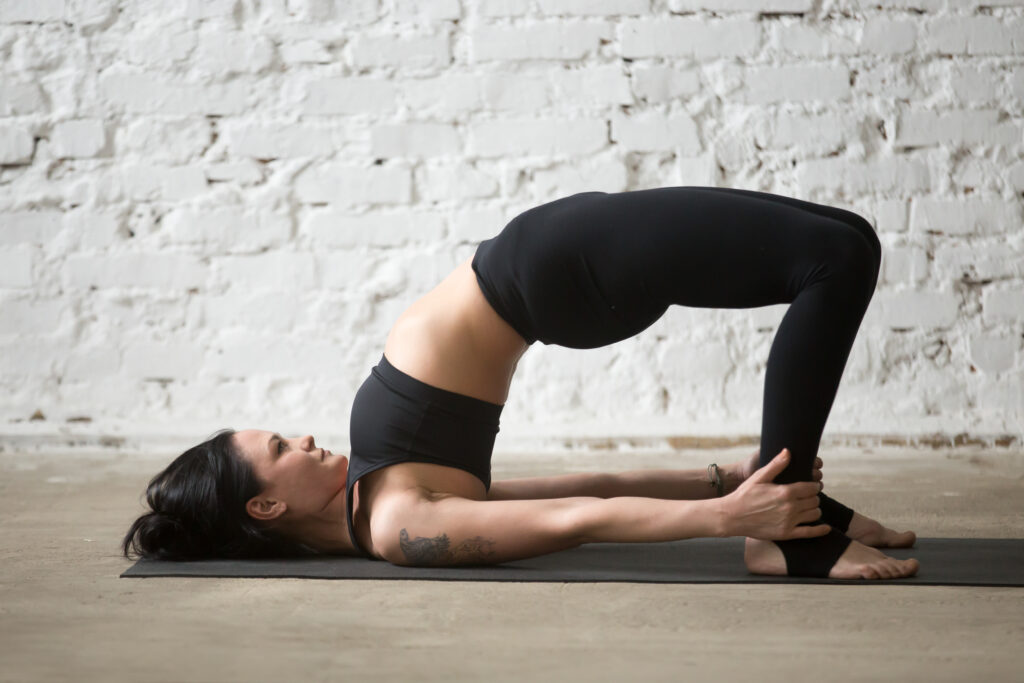 This pose is helpful to strengthen the lower back and thighs.
This pose is helpful to strengthen the lower back and thighs.
How to Practice Bridge Pose?
- Place your back on the floor, bend both knees, and keep your feet flat.
- Place your arms on your sides and keep them straight along with your palms.
- Slowly raise your hips with a gentle inhaling.
- Lift your hips at a height where you may achieve a position that allows a straight line position of your knees, hips, and shoulders.
- Hold this pose for 10 seconds.
- Bring your hips back to the original position with a gentle exhale.
- Repeat the practice at least five times.
Yoga for Sciatica and Precautions
Sciatica is a painful sensation that causes injury in your nerves. Keeping care of body posture during yoga is very important because any carelessness can cause severe harm to your vertebrae, joints, or nerves. Some tips before performing yoga for sciatica relief are:
- Use of medications in case of any underlying health issue is normal but whenever you plan to perform yoga for sciatica pain relief, you must discuss your medications with your doctor because sedative medicines or medical conditions that cause extra flexibility in your joints, muscles, or ligaments, are prohibited during yoga practices. You may not perform yoga practice if you are taking such medications.
- Yoga is effective in finding sciatica relief. Every person has different body types and health conditions. Therefore, it’s normal that a specific pose may help your friend but it may not work for you. You need to try out different poses to find the most effective yoga pose for yourself as sciatica relief.
Yoga Poses a Danger for Sciatica
Some yoga poses are not suitable for sciatica pain. If you have sciatica you should avoid them. Since the symptoms may get worse due to those yoga poses.
- Always listen to your body and never practice a pose that pushes you into a bad condition. Or cause harm to you.
- Do experiments to check which pose works best on any given day.
- Sometimes, sitting or standing forward bends like Downward-Facing Dog Pose, can cause unnecessary strain on your lower back and pelvis. These unusual bends can also upset your spine position. So you should avoid such poses.
- Usually, sciatica affects only one leg, so you must find the best poses that can be performed on only one side of the body.
- For knee-bending poses, always place cushions under your knees. This may save your knees from pressure and fracture.
- If you are pregnant and also have sciatica pain, avoid doing yoga for sciatica relief. Don’t practice a pose that compresses your stomach. Avoid poses that put strain or pressure on your belly. Don’t perform strong backhands or twists. For modifying the poses, use cushions or bolsters.
Conclusion
To get relief from sciatica pain, yoga poses are the most effective way. Yoga poses may help you feel better but always prefer your ease and safety. Selection of a suitable yoga practice for yourself is an important job. So try to check in with a professional while you are going to attend the yoga session for the first time. On your way to get relief from sciatica by yoga poses, talk to your doctor at least once a month to make sure that you’re doing a good job. If you have unusual symptoms of sciatica or have sciatica pain that lasts longer than 30 to 40 days, immediately see your doctor or physical therapist.







